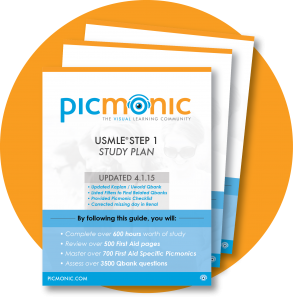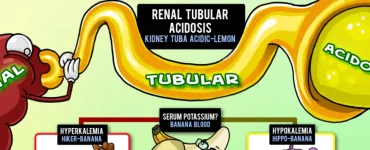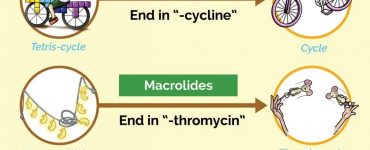Many of you may be entering crunch time, asking yourself, “If I have 10 days left before my exam, how do I get the most out of Picmonic?” Great question! Picmonic offers more than 3,300 high yield facts for over 340 topics, and this list is growing every day. So it’s technically impossible to learn and retain everything Picmonic has to offer in a 10 day cram session, no matter how good your study plan may be. However, we devised a USMLE Step 1 study schedule to help to maximize the value you get out of Picmonic in only 10 days.
If you’ve already learned all of Picmonic’s cards once:
Launch all of your cards and enter full screen mode, scan through the image and check to ensure you remember what the characters represent. Rate (or update) your level of confidence.
Utilize the Confidence Pie Chart in your profile and launch the cards you’re least confident about (the red section of your pie).
Spend time really reviewing the information (in the topic overview, not just the picture) for your weakest cards. Make your own USMLE Step 1 study schedule that divides up your weakest cards over 10 days so you can spread out the work.
If this is your first time using Picmonic:
If you’re just now subscribing to Picmonic for some last minute review, but you know you need help on a particular area, here’s how to find and focus on those topics. Visit the Library and make sure you’re looking at the “list view” so you can see the breakdown of topics by category and subcategory. Go through the list and choose topics that you feel weak about. Study these cards over 10 days, ranking your confidence as you go along, and spend your last few days mastering at least 30 of those cards.
If you have no idea which topics you need to focus on, here’s a list of SUPER high-yield topics, based on high frequency of appearance on the Step 1 exam and a high difficulty level. We recommend an hour each day to master these 30 topics in 10 days.
Search for these topics using the “search bar” in the upper right corner of the Library.
- Severe Combined Immunodeficiency (First Aid 2013 page 207)
- Bruton’s Agammaglobulinemia (First Aid 2013 page 206)
- Common Variable Immunodeficiency (First Aid 2013 page 206)
- Digoxin Mechanism and Indication (First Aid 2013 page 282)
- Digoxin Toxicity (First Aid 2013 page 282)
- Multiple Myeloma Pathophysiology (First Aid 2013 page 363)
- Multiple Myeloma Symptoms (First Aid 2013 page 363)
- Dilated cardiomyopathy (First Aid 2013 page 272)
- Restrictive cardiomyopathy (First Aid 2013 page 272)
- Bacterial endocarditis (First Aid 2013 page 274)
- Rheumatic fever (First Aid 2013 page 274)
- Focal segmental glomerulosclerosis (First Aid 2013 page 490)
- Rapidly progressive glomerulonephritis (First Aid 2013 page 492)
- Maple syrup urine disease (First Aid 2013 page 109)
- Pyruvate dehydrogenase deficiency (First Aid 2013 page 101)
- Campylobacter jejuni (First Aid 2013 page 136)
- Syphilis (First Aid 2013 page 138)
- Clostridium botulinum (First Aid 2013 page124)
- Cornybacterium diphtheria (First Aid 2013 page 130)
- Adenovirus (First Aid 2013 page 155)
- Varicella zoster (First Aid 2013 page 156)
- Tuberous sclerosis (First Aid 2013 page 85)
- Von Hippel Lindau (First Aid 2013 page 85)
- P450 inducers (First Aid 2013 page 242)
- P450 inhibitors (First Aid 2013 page 242)
- Kawasacki disease (First Aid 2013 page 276)
- Henoch Schonlein Purpura (First Aid 2013 page 277)
- Vitamin A Toxicity (First Aid 2013 page 90)
- Vitamin D Toxicity (First Aid 2013 page 94)
- Wernicke Korsakoff (First Aid 2013 page 90)
Extra Tips
Here’s a few last quick tips to stay organized during crunch time.
1. Use the confidence scale to its fullest potential. Don’t forget that you can view these personal ratings in the Library as well as your Profile. The pie chart in your profile lets you quickly launch the cards you want to review.
2. Flag topics that you want to isolate in the Library later. It’s one click to select your flagged cards and one more to launch them all. Focus!
3. Mark individual attributes that are giving you grief. If you’re struggling to remember one or two of those facts in your list, click on the number on the far left. This puts a little red box around the number so you remember to focus on it extra the next time you come across the card.
4. Use full screen for less distraction. You can also use this feature to hide the list of attributes and quiz your knowledge of the picture representations.
Whether you have 10 days left or 110, we know you’re going to do big things. We’re rooting for you!

Plus, check out other Step 1 Resources in our Step 1 Resource Portal.













